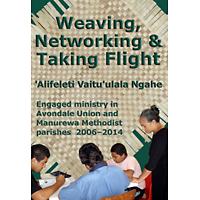‘Alifeleti Vaitu’ulala Ngahe
Weaving, Networking and Taking Flight: Engaged Ministry in Avondale Union and Manurewa Methodist Parishes 2006-2014
(Wellington: Philip Garside, 2014), 68pp.
Review by:
Rosemary Dewerse, Mission Educator, College of St John the Evangelist, Auckland.
(This review will be published in the December 2015 issue of the
Australian Journal of Mission Studies.)
“In our part of the world where practitioners significantly outnumber academics in the field of missiology, we often do not benefit from their wisdom because they are too busy “doing.” This is especially the case with Pacifica leaders. In this remarkable little book Rev Ngahe, a Tongan Methodist minister working in Auckland, New Zealand, does, however, take the time to pause and record his ministry strategy across 2006-2014, a strategy that because of its deeply contextual and outward-facing commitment exemplifies missional church leadership.
Ngahe’s strategy is straightforward. He seeks out visual images that can capture his own but also his people’s imagination and then explores their riches as he leads his community in building connections within and beyond their own boundaries in service of Christ and the people.
For himself as a Tongan the image of a Fala (a mat woven by one’s family) keeps him humble in reminding him that when he joins a community he joins a history and comes to contribute to that. It keeps him open as a Fala’s purpose is to invite family and others into talanoa (conversation seeking agreed solutions). It also keeps him mindful that when he moves on it is good for the people to be continuing to weave a closely interlaced Fala.
When Ngahe arrived in Avondale, Auckland, in 2006 he found the local icon of the Avondale spider. This got him thinking about the care with which a spider (in his imagination, God) weaves a web that despite the weather holds fast. The legs of the spider he saw as us all doing God’s work in reaching out across the community web through good and difficult times. Such thinking saw him lead the renewal of a rundown church building by seeking and welcoming help offered by likely as well as unlikely groups (eg the NZ Methodist Church, local businesses, the Mormons, the Department of Corrections). The congregation had a vision of being ‘Christ’s light to the community’ by running a homework club as a way to begin reversing endemic unemployment in the area; it was a vision others wanted to support, though there was some discomfort at first amongst parishioners with some of their partners. Though Ngahe left in 2010, the club, and other community activities, continue to this day in the refurbished church.
In Manurewa the image drawn upon was the name of the suburb: in Maori it means “soaring bird.” There, as Ngahe notes, “the listening and storytelling took pictorial shape” (p26). A mural on this corner church was painted with the help of local businesses, community police, local graffiti taggers, and MPs, as well as church members. They and nearly 40 other community groups now see “The Corner of Hope” (the name of the Church) as a place of welcome and belonging for all people. Hospitality and transformation are the two key theological themes underpinning all that happens there.
For Ngahe it is clear that finding a language that embeds God’s mission in the local context and in words and deeds that all people can understand and feel embraced by is crucial. It is exemplified not only in his approach to his ministry but also in the way in which he has written this most accessible book. Church leaders and lay alike will find humble but passionate vision and wisdom here.”
Order now eBooks or Print book

